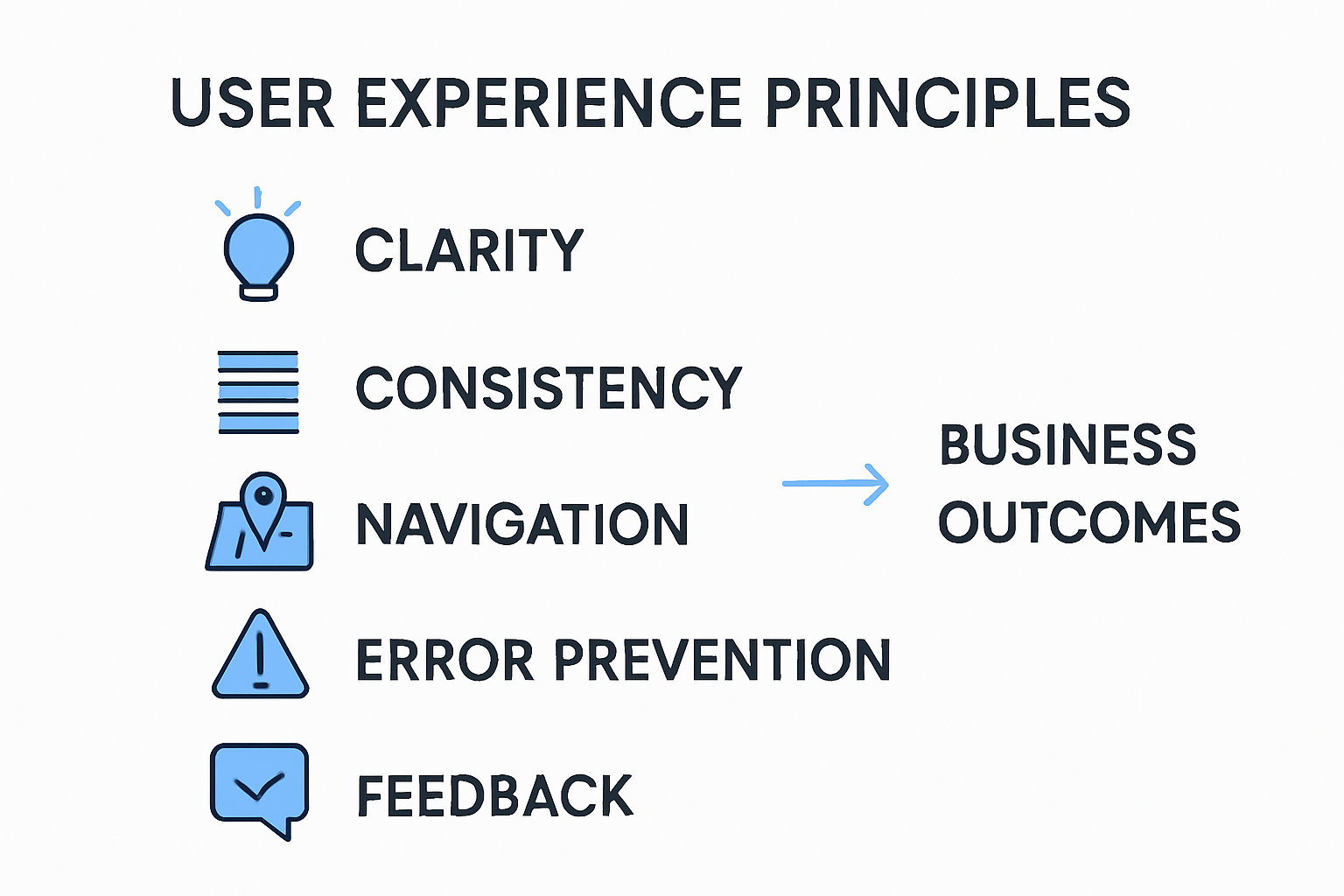User experience has become a make-or-break factor for any business wanting to prosper in 2025. Some companies are still treating UX as just another checkbox, yet the numbers tell a completely different story. For every Rand spent on UX, businesses can see up to 100 Rand come back in revenue. This means the companies still stuck in the old way are actually leaving mountains of cash on the table while their competitors run ahead.
Table of Contents
- What User Experience Means for Modern Businesses
- Core Elements of Effective User Experience Design
- User Experience Strategies for Digital Transformation
- Leveraging UX to Boost Business Results Globally
Quick Summary
| Takeaway | Explanation |
|---|---|
| User experience is essential for business success | Companies must prioritize user experience to enhance customer satisfaction and drive revenue growth. |
| Investments in UX yield substantial returns | Research shows that every Rand invested in UX can generate up to 100 Rand in additional revenue. |
| Ongoing UX refinement is crucial | User experience should be an evolving process involving continuous research, testing, and updates to adapt to changing user needs. |
| Effective UX improves key business metrics | Businesses focusing on UX experience increases in conversion rates, customer loyalty, and overall competitive advantage. |
| Implement user-centric digital strategies | Organizations must create tailored, adaptive solutions that enhance user engagement across various digital platforms. |
What User Experience Means for Modern Businesses
User experience (UX) has transformed from a design afterthought to a critical strategic business imperative in 2025. Modern businesses recognise that UX is no longer just about creating visually appealing interfaces, but about crafting comprehensive digital interactions that directly impact bottom-line performance.
The Strategic Significance of User Experience
At its core, user experience represents the holistic journey a customer experiences when interacting with a digital product or service. According to Nielsen Norman Group, UX encompasses all aspects of an end-user’s interaction with a company, its services, and its products. This comprehensive approach means businesses must think beyond superficial design elements and consider every touchpoint of digital engagement.
Modern organisations understand that exceptional UX is a competitive differentiator. Forrester Research indicates that every R1 invested in UX can return up to R100 in additional revenue. This remarkable return demonstrates why forward-thinking businesses are prioritising user-centred design strategies.
Practical Implications for Business Performance
Effective user experience directly influences key business metrics. Companies that prioritise UX design see measurable improvements in customer satisfaction, retention rates, and conversion potential. Poor UX, conversely, can lead to significant revenue losses and brand reputation damage.
Consider these critical UX performance indicators:
- Conversion Rates: Well-designed interfaces can increase conversion rates by up to 400%
- Customer Loyalty: 88% of online consumers are less likely to return to a website after a bad experience
- Competitive Advantage: UX-focused companies outperform their competitors by consistently delivering more intuitive, seamless digital interactions
Businesses must recognise that user experience is not a one-time project but an ongoing strategic commitment. It requires continuous research, testing, and refinement to understand evolving user expectations and technological capabilities.
The most successful digital strategies in 2025 will be those that view UX not as a technical requirement, but as a fundamental approach to understanding and serving customer needs. By placing users at the centre of digital design and development, businesses can create more meaningful, effective, and ultimately profitable digital experiences.
To help highlight UX’s tangible business impact, here’s a table summarising key statistics and performance indicators mentioned above.
| Metric | Value/Statistic | Source/Context |
|---|---|---|
| Conversion Rate Increase | Up to 400% | Well-designed interfaces |
| Customer Loyalty Loss | 88% of online consumers less likely to return after a bad experience | Customer loyalty |
| Return on UX Investment | R1 invested returns up to R100 | Forrester Research |
| Design-Focused Company Growth | 219% outperformance over S&P 500 (2004-2014) | Design Management Institute |
Core Elements of Effective User Experience Design
Effective user experience design transcends aesthetic appeal, requiring a strategic blend of technological insight, psychological understanding, and user-centric methodologies. In 2025, businesses recognise that exceptional UX design is a precise science that demands comprehensive consideration of multiple interconnected elements.
Fundamental Design Principles and User Interaction
The core of exceptional user experience lies in understanding and implementing fundamental design principles that facilitate intuitive interaction. According to the User Experience Design & Technology Guidelines, successful UX design hinges on several critical attributes: clarity, consistency, navigation efficiency, error prevention, and responsive feedback mechanisms.

Research from Culturally Responsive Computing highlights key cognitive principles that inform effective design strategies. These include principles like attention management, recognition over recall, and adherence to established interaction standards. Designers must create interfaces that anticipate user needs, minimise cognitive load, and provide immediate, meaningful responses.
The table below summarises the fundamental design principles and cognitive strategies discussed in this section.
| Principle/Attribute | Description |
|---|---|
| Clarity | Ensures interface elements are easily understood |
| Consistency | Maintains uniformity in design and interactions |
| Navigation Efficiency | Provides straightforward, logical pathways for user actions |
| Error Prevention | Minimises user errors via design and prompts |
| Responsive Feedback | Users receive timely, relevant responses to actions |
| Attention Management | Directs user focus to important tasks |
| Recognition over Recall | Favors familiar cues over memory-dependent elements |
| Interaction Standards | Adheres to established user expectations and conventions |
Technological Adaptability and User-Centric Innovation
Modern UX design demands technological flexibility and adaptive strategies. Businesses seeking to enhance their digital experiences must integrate design principles that accommodate diverse user contexts, technological platforms, and interaction modalities.
Key technological considerations include:
- Responsive Design: Ensuring seamless experiences across multiple devices and screen sizes
- Accessibility: Creating interfaces that accommodate users with varying abilities and technological proficiencies
- Performance Optimization: Developing lightweight, fast-loading interfaces that maintain high interactivity
The most successful UX designs transcend technical implementation, creating emotional connections that transform functional interactions into memorable experiences. This requires deep empathy, continuous user research, and a willingness to iterate based on real-world feedback.
Businesses must view user experience as a dynamic, evolving discipline that demands ongoing attention, research, and refinement. By prioritising user needs, embracing technological innovation, and maintaining a commitment to intuitive design, organisations can create digital experiences that not only meet but consistently exceed user expectations.
User Experience Strategies for Digital Transformation
Digital transformation in 2025 is fundamentally driven by strategic user experience approaches that go beyond traditional technological implementations. Businesses must reimagine their digital ecosystem through a lens of holistic user engagement, integrating sophisticated UX methodologies that create meaningful, adaptive interactions.
Strategic UX Framework for Organisational Change
Successful digital transformation requires a comprehensive UX strategy that aligns technological capabilities with human-centred design principles. According to Gartner Research, organisations that embed user experience deeply into their transformation strategies are 2.5 times more likely to achieve successful digital initiatives.
The strategic UX framework involves multiple critical dimensions:
- Customer Journey Mapping: Thoroughly understanding and designing comprehensive interaction pathways
- Technological Integration: Seamlessly connecting user touchpoints across digital platforms
- Data-Driven Personalization: Leveraging user insights to create tailored digital experiences
Implementing User-Centric Digital Solutions
Businesses seeking to revolutionise their digital strategies must adopt a multi-dimensional approach to UX design. MIT Sloan Management Review emphasises that effective digital transformation is not about implementing new technologies, but about reimagining how organisations create value through user-focused digital experiences.
Key implementation strategies include:
- Developing adaptive interfaces that respond dynamically to user behaviour
- Creating cross-platform experiences that maintain consistency and intuitive navigation
- Implementing continuous feedback mechanisms for ongoing UX refinement
The most progressive organisations recognise that digital transformation is an ongoing journey, not a destination. By maintaining a flexible, user-centric approach, businesses can create digital ecosystems that are not just technologically advanced, but genuinely responsive to evolving user needs.
Ultimately, successful digital transformation demands a radical shift from technology-first to human-first thinking. Companies must view user experience not as a technical requirement, but as a strategic imperative that drives innovation, customer loyalty, and competitive differentiation in an increasingly digital marketplace.
Leveraging UX to Boost Business Results Globally
In the global business ecosystem of 2025, user experience (UX) has emerged as a critical differentiator that directly translates into measurable financial performance. Companies worldwide are recognising that strategic UX investment is not merely a design consideration, but a powerful mechanism for driving competitive advantage and economic growth.
Quantifying UX Impact on Business Performance
The economic significance of user experience is profound and quantifiable. According to the Design Management Institute, companies prioritising design outperformed the S&P 500 Index by an extraordinary 219% between 2004 and 2014. This demonstrates that thoughtful UX strategies can yield substantial financial returns.
Research from mobile application studies reveals critical performance metrics that highlight UX’s transformative potential. Key findings indicate that intuitive navigation, appealing visual design, and seamless performance optimization directly correlate with increased user retention, higher conversion rates, and enhanced customer satisfaction.

Strategic UX Implementation for Global Competitiveness
Businesses seeking to optimise their digital experiences must adopt a holistic approach that transcends traditional design boundaries. According to end-user computing research, positive user experiences not only impact external customer interactions but also significantly influence internal organizational performance.
Key strategic considerations for global UX implementation include:
- Cross-Cultural Design: Creating interfaces that accommodate diverse user expectations and cultural nuances
- Adaptive Technologies: Developing flexible solutions that perform consistently across different technological ecosystems
- Continuous Improvement: Establishing robust feedback mechanisms for ongoing UX refinement
Global organisations must recognise that effective UX transcends aesthetic considerations. It represents a comprehensive approach to understanding and addressing user needs across diverse contexts. By investing in sophisticated UX strategies, businesses can create digital experiences that are not just functional, but emotionally resonant and strategically powerful.
Ultimately, successful global businesses in 2025 will be those that view user experience as a core strategic capability. This requires moving beyond traditional design thinking to create integrated, empathetic digital solutions that anticipate and exceed user expectations across different markets, technologies, and cultural contexts.
Frequently Asked Questions
What is user experience (UX) and why is it important for businesses in 2025?
User experience (UX) refers to the overall journey a customer has when interacting with a business’s digital products or services. In 2025, UX is crucial as it directly influences customer satisfaction, retention rates, and revenue growth, making it a key differentiator in a competitive market.
How can investing in user experience impact a company’s revenue?
Research shows that for every Rand invested in UX, businesses can expect up to R100 in return. This significant ROI highlights the importance of prioritising user-centric design strategies to enhance overall business performance.
What are the fundamental principles of effective user experience design?
Effective UX design includes principles such as clarity, consistency, navigation efficiency, error prevention, and responsive feedback. These principles ensure that users have a seamless and intuitive interaction with digital interfaces.
How do companies measure the impact of user experience on business performance?
Companies measure UX impact through performance indicators like conversion rates, customer loyalty, and overall satisfaction. For instance, well-designed interfaces can increase conversion rates by up to 400%, underlining the tangible benefits of investing in UX.
Turn User Experience Into Powerful Business Growth
Are you frustrated by digital platforms that fail to keep customers engaged or struggle to deliver real returns? The article showed how neglecting user experience holds businesses back. If your goal is to boost conversion rates, strengthen customer loyalty and stay relevant in 2025, then prioritising intuitive design and seamless interactions is no longer optional. You learned that with the right approach to UX, every Rand spent can multiply your business revenue dramatically.
Let your next big breakthrough start with Cloudfusion’s expertise in crafting custom, impactful digital solutions. Our team blends strategic insight with technical excellence to make your brand stand out. Ready for interfaces that delight users and drive results? Take the first step and get your personalised web design and development quotation today. Or explore the full power of our cutting-edge solutions built for South African business success. Act now and experience what next-level user experience can do for you with Cloudfusion.
Recommended
- User Experience in Web Design: Best Practices for Businesses 2025
- Responsive Web Design in 2025: A Complete Guide for Businesses
- Mobile App Development Process for Businesses in 2025
- Why Businesses Need Websites in 2025: Key Benefits Explained
- User Experience Testing Strategies for CRO & Growth in 2025
- undefined








